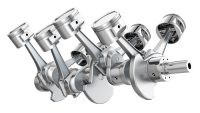Vehicles are propelled into motion through a fascinating interplay of processes within the internal combustion engine (ICE). This engine masterfully orchestrates fuel ignition and combustion, converting this energy into both heat and the mechanical force known as torque. This intricate process relies on a multitude of car engine parts, each with distinct functions, working in perfect harmony. Understanding these components is not just for mechanics; it’s beneficial for every car owner.
Exploring the Core Components of Your Car Engine
To understand how your car moves, let’s delve into some of the most crucial parts of a car engine and explore their functions:
1. Engine Block and Cylinders: The Foundation
The engine block serves as the robust backbone of your car’s engine. Typically constructed from durable materials like aluminum or iron, it provides the housing for the engine’s most vital internal parts. Imagine it as the engine’s skeleton, encasing components such as pistons, the crankshaft, and connecting rods. The engine block is structurally divided into key sections: the cylinder head, the main block itself, and the crankcase.
Within the engine block are hollow cylinders – usually 4 to 16 in number depending on the engine type. These metal tubes are where the magic of combustion happens and where pistons move. The diameter of these cylinders plays a crucial role in determining the engine’s displacement, a key factor in engine power. Furthermore, the engine block contains essential pathways for coolant and oil, vital for maintaining optimal engine temperature and lubrication, preventing overheating and wear.
2. Pistons and Crankshaft: Converting Power
 Pistons connected to the crankshaft in a car engine, illustrating the conversion of linear motion to rotational motion.
Pistons connected to the crankshaft in a car engine, illustrating the conversion of linear motion to rotational motion.
The journey of rotational force that ultimately drives your wheels begins with the pistons. Pistons are the crucial components responsible for capturing the energy unleashed during the combustion cycle. Their primary function is to transfer this energy to the crankshaft, effectively setting your vehicle in motion.
Pistons achieve this by moving in a reciprocating motion – up and down – within the cylinders. This movement is a direct response to the heat and expanding gases generated during fuel combustion. Connected to the pistons via rods is the crankshaft, situated in the lower part of the engine block. The crankshaft’s ingenious design allows it to convert the piston’s linear (up and down) motion into a rotational motion. This rotational force is then transmitted to the car’s wheels, propelling it forward.
The crankshaft is a precision-engineered component, demanding precise balancing for optimal performance. Its design incorporates strategically placed holes that ensure balance is maintained even when rotating at high engine speeds.
3. Camshaft: The Valve Timing Regulator
The camshaft is a critical component in the engine’s orchestration. Its primary function is to regulate the timing of the engine valves’ opening and closing. It achieves this by exerting pressure on the valve stems at precisely timed intervals. Without the camshaft’s accurate valve control, initiating the engine would be impossible.
Conversely, the camshaft also harnesses the rotary motion from the crankshaft and transforms it back into linear motion. This intricate interaction ensures the valves operate in perfect synchronization with the pistons and combustion cycle.
The Vital Role of Engine Cooling
While the synchronized operation of all the aforementioned car engine parts is paramount for your vehicle’s engine performance, maintaining optimal temperature is equally crucial. This is where the engine cooling system comes into play.
The intense processes within a running engine, particularly combustion and the constant movement of components, generate significant heat. Without an efficient cooling system to dissipate this heat, the engine would rapidly overheat. Overheating can lead to severe engine damage, ranging from breakdowns to catastrophic failures.
Often located beneath the timing belt cover is the water pump, considered the heart of the engine cooling system. The water pump’s function is to circulate coolant throughout the engine block. This coolant absorbs excess heat and carries it away from the engine, allowing it to be dissipated into the outside air via the radiator. This continuous circulation of coolant is essential for preventing engine overheating and ensuring reliable operation.
DOLZ provides high-quality spare parts for vehicle maintenance, including water pumps, thermostats, and timing kits. Explore our product range to ensure the longevity and performance of your engine. Your safety and vehicle health are our priority since 1934.